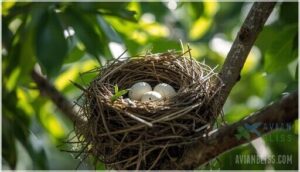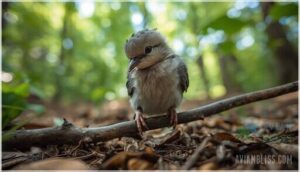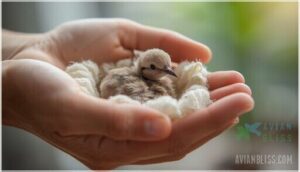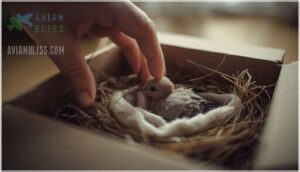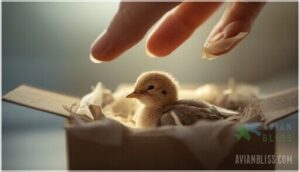This site is supported by our readers. We may earn a commission, at no cost to you, if you purchase through links.

These devoted birds operate on a schedule that doesn’t match our expectations, feeding their young only two to three times daily while spending the rest of their time foraging far from the nest. Before you intervene, you’ll need to distinguish between a baby that’s temporarily alone and one that’s genuinely been left behind, because the wrong move can separate a healthy chick from parents who are actually just out of sight.
Table Of Contents
- Key Takeaways
- Do Mourning Doves Leave Their Babies Unattended?
- Mourning Dove Nesting and Parenting Behavior
- Understanding an Abandoned Baby Dove
- Baby Mourning Dove Found on The Ground
- How to Help an Abandoned Baby Dove
- Contacting a Wildlife Rehabilitator for Assistance
- Monitoring The Abandoned Baby Dove’s Condition
- Conservation of Mourning Doves and Wildlife Assistance
- Frequently Asked Questions (FAQs)
- Do mourning doves leave their babies unattended?
- What to do with an abandoned baby dove?
- What should I do if I find a baby mourning dove on the ground?
- How long do mourning doves stay with their babies?
- What do baby mourning doves look like?
- When do baby mourning doves start flying?
- What is the diet of adult mourning doves?
- How does weather affect baby doves survival?
- How many broods do mourning doves have annually?
- What do baby mourning doves eat in the wild?
- Conclusion
Key Takeaways
- Mourning dove parents naturally leave their babies unattended for several hours at a time to forage, feeding only two to three times daily, so what looks like abandonment is usually just normal parenting behavior.
- Before intervening with a baby dove on the ground, check if it’s warm, alert, and developing feathers—then watch for parental return over several hours, since parents often feed unseen and may only be temporarily away.
- If a baby dove truly needs help, your immediate priorities are providing warmth with a heating pad or wrapped water bottle, placing it in a safe elevated location away from predators, and contacting a licensed wildlife rehabilitator within 24 hours rather than attempting to feed it yourself.
- Federal law prohibits keeping or treating wild birds without permits, and improper feeding can be fatal, so professional rehabilitators are essential for giving abandoned baby doves their best chance at survival.
Do Mourning Doves Leave Their Babies Unattended?
You might notice mourning doves leaving their babies unattended during the day, but this is often normal absence rather than permanent abandonment. As chicks grow older, parental absence becomes more frequent because of foraging habits. By the time nestlings reach 7 to 10 days old, parents may leave for several hours to find seeds and water, which they need to produce crop milk for feeding. This dove behavior is perfectly natural and doesn’t signal distress. However, if you observe no feeding activity for over 12 hours, or the absence extends beyond 24 hours, temporary abandonment may have shifted to something more serious.
Mourning doves thrive in man-altered habitats, which contributes to their adaptability. Nest monitoring helps you distinguish between routine foraging trips and true neglect, so you can decide when understanding an abandoned baby dove requires professional help through abandoned baby dove care from a wildlife rehabilitator.
Mourning Dove Nesting and Parenting Behavior
Before you can help a baby dove, it’s worth understanding how mourning doves usually raise their young. These birds have specific nesting habits and parenting patterns that can help you determine whether intervention is truly necessary.
Let’s look at where they build their nests, what those nests look like, and how long they stick around to care for their babies.
Nest Placement
When you’re looking for mourning dove nests, check both high and low—these adaptable birds nest anywhere from ground level up to 50 feet. You’ll often spot nests 5 to 15 feet up in trees, shrubs, or even on your porch ledge, gutter, or balcony.
In urban areas, over 70% of nests sit within 30 feet of homes, showing how comfortable these doves are around people. Out west, where trees are scarce, up to 25% of nests rest directly on the ground under protective shrubs.
Mourning doves prefer spots with moderate cover—enough foliage to conceal the nest while still allowing some light through—which greatly improves their babies’ survival chances. Mourning doves exhibit a high tolerance for human presence.
Nest Description
Once you spot the nest location, you’ll notice mourning dove nests look surprisingly flimsy—just a loose platform of pine needles, grass stems, and small twigs woven together. These nests generally measure 6 to 7 inches wide and 2 to 3 inches deep, with visible gaps between materials.
The male gathers nest materials while the female oversees nest construction, completing nest building in just 2 to 4 days. Despite their fragile appearance, these nests adequately support two eggs through the 14-day incubation period.
Length of Parental Care
After nest construction wraps up, parental care kicks in and lasts about 12 to 15 days during the nestling phase. Both parents share feeding duties—delivering crop milk at first, then seeds—roughly every hour through daylight.
Once fledglings leave the nest, they’re not on their own yet. Post-fledging support continues for another 15 to 30 days as young doves learn to forage and fly, with males often taking the lead while females prep the next clutch.
This overlapping cycle of parental responsibilities allows mourning doves to raise multiple broods each season without skipping a beat.
Understanding an Abandoned Baby Dove
How do you know if a baby mourning dove is truly abandoned, and what urgent steps can you take to help? Understanding the difference between normal parenting behavior and actual abandonment is critical for these vulnerable birds. When you spot a lone baby mourning dove, time matters. Here’s what to assess immediately:
- Check for warmth: A cold baby dove is at serious risk and needs help fast.
- Look for signs of distress: Wrinkled skin, drooping posture, or a flat crop (the bulge near the throat) after 24 hours signals trouble.
- Watch for parental return: Parents may be feeding unseen, returning only 2-3 times daily for brief visits.
- Note the nest location: If the nest is intact and nearby, the parents might still be caring for their young.
- Consider disturbances: Human activity, predators, or weather can temporarily scare parents away.
Your quick, informed response can mean the difference between life and death for abandoned baby dove care.
Baby Mourning Dove Found on The Ground
Finding a baby mourning dove on the ground can feel like a race against time, but taking a moment to assess before acting makes all the difference. You’ll need to determine whether the bird truly needs help or if the parents are still nearby and caring for it.
Let’s walk through how to evaluate the situation and what steps to take next.
Assessing The Situation
When you find a baby dove on the ground, your first move should be checking for signs of nest abandonment versus normal fledging behavior. Observe the chick’s physical condition closely—is its body warm or cold, are feathers developing, and does it appear alert or lethargic?
Watch for parental return over several hours, since adults often forage away from the nest but come back regularly to feed. Environmental risks like storms or predators may temporarily keep parents away, so monitoring nest stability and listening for adult cooing nearby helps you gauge the baby dove’s survival chances before intervening.
Recommended Actions
If you’re certain the baby dove needs help, your first priority is providing warmth and shelter. A wrapped heating pad or soft cloth will bring its body temperature back to safety.
Place the chick in an elevated, protected spot away from predators, but don’t attempt feeding until you’ve contacted a wildlife rehabilitator for Emergency Care guidance.
Improper dove nutrition can be fatal, so always reach out to wildlife support professionals within 24 hours to assess the baby dove’s condition and get rehabilitation tips that guarantee baby safety.
How to Help an Abandoned Baby Dove
Once you’ve confirmed a baby dove needs help, your first priority is keeping it alive until professional care is available. The three essentials—warmth, nutrition, and safety—can make the difference between survival and tragedy.
Here’s how to provide each one correctly.
Providing Warmth
When a baby dove loses its parents, warmth becomes its lifeline—without it, body temperature can plummet dangerously within half an hour. Here’s how you can provide thermal care until professional help arrives:
- Use a heating pad on low or a warm water bottle wrapped in cloth, keeping one side of the box around 85-95°F to prevent hypothermia
- Line the container with soft fabric and cover it partially to retain heat while allowing the nestling to move away if needed
- Check every 30 minutes to verify consistent warmth without overheating beyond 108°F, which risks dehydration
Proper heat management doubles survival odds and stabilizes the dove before a rehabilitator takes over.
Providing Food and Water
Feeding an abandoned baby dove requires specialized care and attention. Unlike tossing breadcrumbs, it involves using a commercial handfeeding formula designed specifically for doves, warmed to body temperature, and administered every 2–3 hours with a small syringe. It is crucial to avoid giving water directly, as aspiration can be fatal; instead, hydration should come from the properly mixed formula. Monitoring the crop is essential to prevent overfeeding, which can lead to digestive complications in nearly one-fifth of cases.
| Age Stage | Food Sources & Nutrient Balance | Feeding Techniques & Hydration Methods |
|---|---|---|
| Hatchling (0–7 days) | Commercial dove formula (mimics crop milk’s fats, proteins, antibodies) | Feed every 90–120 minutes; runny consistency; fill crop gently without stretching |
| Nestling (7–14 days) | Formula plus moistened seeds beginning around day 10 | Feed every 2–3 hours; thicker, applesauce-like texture; monitor weight gain daily |
| Fledgling (14+ days) | Shift to solid seeds; shallow water bowl under supervision | Feed every 3–4 hours; introduce independent drinking as solid food increases |
| Critical Warning | Never use cow’s milk, bread, or infant formula—improper avian diet causes fatal digestive issues | Avoid forcing water into mouth; aspiration pneumonia is a leading cause of death in baby dove feeding |
As the baby dove progresses through developmental stages, its dietary needs evolve. Hatchlings require frequent feedings of a runny formula, while nestlings begin to incorporate moistened seeds. Fledglings transition to solid seeds and learn to drink independently. Throughout all stages, it is vital to adhere to proper feeding techniques and avoid common mistakes that can lead to severe health issues or death.
Placing in a Safe Location
Think of placing the baby dove like tucking it into a protective shelter—safety is everything. Position your ventilated box with soft cloth lining at least 3–6 feet above ground, mimicking natural nest placement while reducing predator risk from cats, dogs, and ground mammals.
Choose a quiet spot near the original nest location, shielded from wind, direct sunlight, and household traffic, to encourage parental return.
This strategic relocation offers vital predator protection and environmental safety, giving your abandoned baby dove the best chance at survival while you monitor for signs of the parents’ response.
Contacting a Wildlife Rehabilitator for Assistance
Once you’ve provided immediate care, your next step is reaching someone who’s legally permitted and trained to care for the baby mourning dove. Federal law under the Migratory Bird Treaty Act prohibits you from keeping or treating wild birds without proper Wildlife Permits, which is why contacting Wildlife Rehabilitator professionals is so important.
Here’s how to connect with the right help:
- Call a 24-hour helpline – Organizations like the Wildlife Rescue League (703-440-0800) or your state wildlife agency can provide Emergency Response guidance and direct you to licensed Rehab Center Locations nearby.
- Use online search tools – The National Wildlife Rehabilitators Association and AnimalHelpNow maintain databases where you can find a wildlife rehabilitator by entering your ZIP code.
- Follow Rescue Protocols during transport – Keep the abandoned baby dove in a ventilated, cloth-lined box in a quiet, dark space, and don’t offer food or water unless instructed.
Rehabilitators follow strict Rehabilitator Guidelines and have the expertise to give your baby mourning dove the specialized Wildlife Rehabilitation Assistance it needs to survive.
Monitoring The Abandoned Baby Dove’s Condition
After you’ve connected with a wildlife rehabilitator, your role shifts to watching over the baby mourning dove until help arrives. Health Checks every 15 to 30 minutes let you catch signs of respiratory distress or lethargy early, which can mean the difference between life and death. Look for steady breathing, normal movement, and moist white droppings with a dark spot—anything else, like green excrement or sunken eyes, signals trouble.
Behavioral Signs matter too: constant trembling, inability to stay upright, or complete unresponsiveness after 24 hours shows the abandoned baby dove is in critical condition.
Keep Providing Warmth and Shelter by maintaining temperatures between 37–40°C (98.6–104°F) with a heating pad, since Environmental Risks like cold or dampness can drop survival rates by 40 percent.
Monitor Nutrition Needs by checking the crop every few hours—an empty crop means starvation is setting in fast.
Conservation of Mourning Doves and Wildlife Assistance
Once you’ve monitored the baby dove’s immediate needs, you’re ready to think beyond rescue. Your backyard can become a haven for mourning doves through habitat preservation—offering native plants, fresh water, and safe nesting spots helps sustain the roughly 346 million doves across the U.S.
Supporting wildlife refuges and local rehabilitation centers strengthens conservation efforts, since these organizations track dove populations, treat injuries, and advocate for environmental sustainability. Reporting sightings to conservation groups adds valuable data about population trends.
If you find an abandoned or injured dove, contact a licensed wildlife rehabilitator immediately; they have the training and resources to give these birds their best chance at survival. Together, these actions guarantee mourning dove conservation remains strong for future generations.
Frequently Asked Questions (FAQs)
Do mourning doves leave their babies unattended?
Mourning doves do temporarily leave their babies unattended, but it’s usually part of their natural foraging routine. After the first few days, both parents take turns leaving the nest to find food, returning regularly to feed and care for their young.
This brief absence doesn’t mean abandonment—it’s how they balance survival with parental care.
What to do with an abandoned baby dove?
If you find an abandoned baby dove, your first step is keeping it warm—use a heating pad or soft cloth to maintain body heat. Don’t offer food right away; instead, focus on creating a quiet, safe space away from pets and disturbances.
Watch for signs of parental return, but contact a wildlife rehabilitator quickly if the bird appears injured, cold, or truly orphaned. They’ll guide you through proper temporary care until the bird can be assessed professionally.
What should I do if I find a baby mourning dove on the ground?
Like a guardian watching over a fallen bird, your instinct to help matters most. If you spot a baby mourning dove on the ground, first check its age and injury signs—fledglings often hop around naturally while learning to fly.
When you find a baby mourning dove on the ground, check for injuries and watch for parents before acting—fledglings naturally hop around while learning to fly
Provide immediate warmth, relocate it safely nearby, and contact a wildlife rehabilitator if parents don’t return within hours.
How long do mourning doves stay with their babies?
Parent mourning doves provide dedicated care for about four to five weeks total. After eggs hatch, you’ll see both parents feeding their young for roughly 12-15 days in the nest.
Once fledglings leave, parental investment continues another one to two weeks as offspring learn essential survival skills like foraging and flying before gaining full independence.
What do baby mourning doves look like?
Wrapped in downy ivory fluff, newborn baby mourning doves resemble tiny clouds. They are helpless, blind, and barely a few centimeters long.
Within two weeks, they undergo a remarkable transformation. They grow juvenile feathers with distinctive white-tipped wing spots and develop dark beaks. By this time, they reach nearly half their adult size before fledging.
When do baby mourning doves start flying?
Baby mourning doves usually begin flying around 12 to 15 days after hatching, with most fledglings leaving the nest at roughly two weeks old. They’re surprisingly quick learners, though their first flights are short and clumsy.
Even after they’ve mastered basic flight development, these fledglings still depend on their parents for another week or two, receiving guidance on finding food and staying safe from predators.
What is the diet of adult mourning doves?
Adult mourning doves are absolutely ravenous seed-eaters, with over 99% of their diet composed of grains like millet, wheat, corn, and wild seeds from plants such as pigweed and ragweed, which they forage from the ground.
How does weather affect baby doves survival?
Weather patterns directly impact baby dove survival through temperature regulation and hydration challenges. Cold or wet conditions lower their body temperature, risking hypothermia and illness, while extreme heat causes dehydration.
Storm impacts can dislodge nests, affecting nest stability and survival rates.
Climate effects shape environmental conditions critical for growth, making moderate weather essential for maintaining the stable temperatures these vulnerable nestlings need.
How many broods do mourning doves have annually?
Mourning doves usually have 3 to 4 broods in a season, though they can produce up to 6 in warmer climates with abundant food.
This high reproductive rate helps offset the significant losses baby mourning doves face from predators and harsh weather.
What do baby mourning doves eat in the wild?
In their first days, hatchlings depend entirely on crop milk, a protein-rich secretion both parents produce that resembles soft cheese.
Around day six, they shift to regurgitated seeds and grains like wheat, millet, and corn, with seeds eventually comprising over 99% of their diet.
Conclusion
Picture a fledgling perched on a low branch, feathers still fluffy, waiting patiently while its parents hunt miles away—this is the natural rhythm of mourning dove babies, not abandonment. Your careful observation makes all the difference between unnecessary intervention and life-saving help.
When you spot mourning dove babies abandoned for real, trust your instincts but give nature a few hours first. Watch from a distance, note the signs, and reach out to wildlife rehabilitators when genuine distress appears. Your patience protects these gentle birds better than immediate action ever could.
- https://bioone.org/journals/wildlife-biology/volume-12/issue-2/0909-6396_2006_12_171_ADIMDZ_2.0.CO_2/Assessing-differences-in-mourning-dove-Zenaida-macroura-marginella-nesting-activity/10.2981/0909-6396(2006)12%5B171:ADIMDZ%5D2.0.CO;2.full
- https://digitalcommons.usu.edu/etd/6499/
- https://digitalcommons.usf.edu/cgi/viewcontent.cgi?article=21324&context=auk
- https://watchbird-ojs-tamu.tdl.org/watchbird/article/view/1536
- https://tpwd.texas.gov/publications/pwdpubs/media/pwd_bk_w7100_009a.pdf

